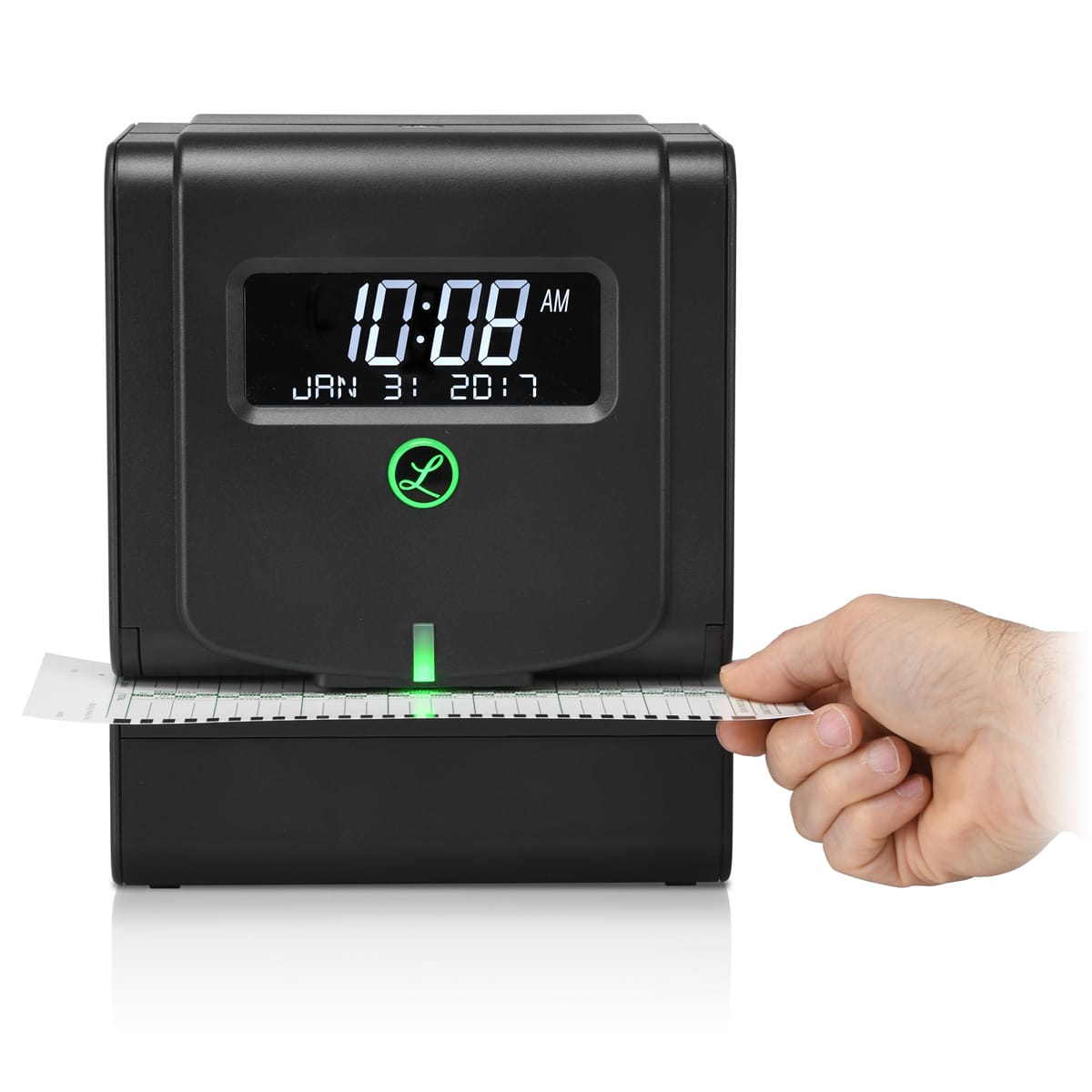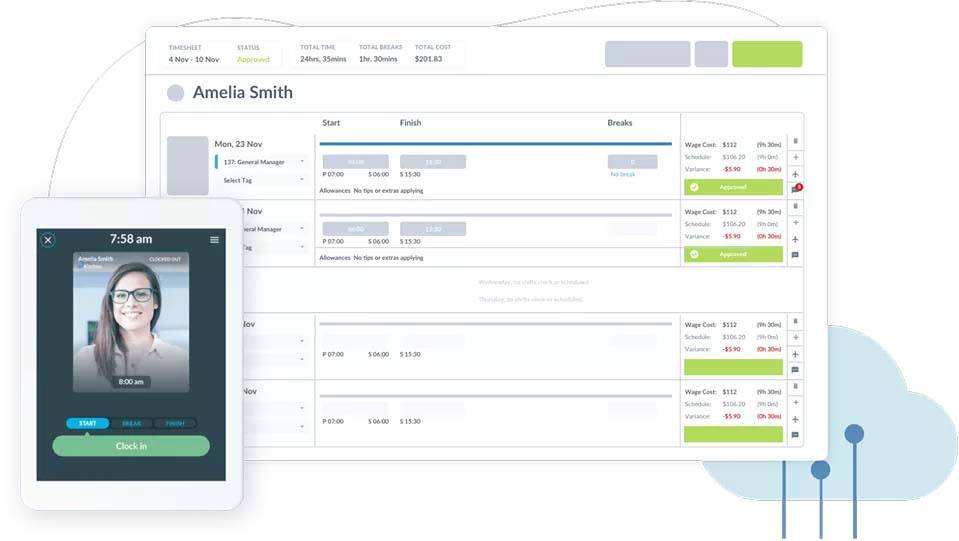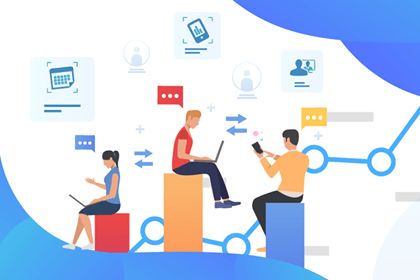Summary
-
Some businesses get away with tracking time manually with pen and paper.
-
Time clock machines with biometrics, card swipes, or punch-in codes are worth considering in most cases.
-
Automated time and attendance software is the easiest and most comprehensive way to track employee hours.
Without a time tracking program in place, it’s easy to lose track of which hourly employees did what and for how long, leading to mistakes in payroll.
Inaccurately tracking hours also creates compliance issue landmines. There are stiff penalties and fines for organizations that ignore local, state and federal wage-and-hour and overtime laws.
It’s a mistake to maintain relaxed standards or have no policy at all to track employee hours.
Time tracking allows you to accurately see how long any given task takes to complete, and who on your team works most efficiently whether they are hourly or salaried employees. Knowing how much time is spent on certain tasks helps employers to efficiently select how their workers should be using their time.
Still, there are some employers who don’t track employee time because they don’t want to offend employees. Introducing time tracking can be seen as micromanaging or an intrusion on employees’ privacy and shows “a lack of faith” in your own employees.
Instead, they rely on an employee monitoring their own time. Showing trust can build commitment to the company but it can open the door to fraud.
Before implementing an employee hour tracking solution, answer all questions your employees may have about the process. If employees don’t see the value of time tracking or it is not accurately communicated, your team may not buy in. A key component of streamlining the process of tracking employee hours begins with your honest, transparent communication.
Not tracking employee hours can result in thousands of dollars in lost revenue and invite expensive wage-and-hour violations. Following are five ways that you can track employee hours.
Whether you need to clean up your compensation and compliance practices, track employee activity on a job site, or gauge exempt employees’ time on a project, there are several ways to track employee hours.
- Manual timekeeping — pen and paper.
- Time clocks or punch-in tools.
- Automated time-and-attendance solutions.
- Mobile apps.
- GPS clock-ins.
1. Manual timekeeping
If your company is small, using a pen and paper to track employee hours may be a workable option. A manual pen-and-paper system or an Excel spreadsheet at least offers a minimal way to track employees’ time at work. But its limitations quickly become evident as a company grows.
Manual timekeeping can lead to many difficulties for employers who want to accurately track employees’ time.
Managers face reams of paperwork on a regular basis, and it’s easy to misplace or lose timesheets. Employee paperwork also is cumbersome to store, and accessing the documents for recordkeeping or auditing is a challenge.
Manual timekeeping can also make calculating payroll seems like an endless task. If a manager’s time is spent sorting through messy, handwritten employee timesheets and contacting them with questions, they have less time to build the organization through more strategic tasks.
Correcting mistakes also could hold up the payroll process, which affects all employees.
Accurately tracking employee time becomes an issue. Employees and employers can only add or delete time manually, so they depend on memory to recall who came in when and at what time they took a break or went home.
Wage-and-hour fraud becomes a real possibility. Time theft practices like buddy punching are difficult to detect. Even if several employees falsely change their clock-in time by just five minutes every day, employers can unwittingly pay dozens of unworked hours over the course of a month.
Of course, the pendulum can swing the other way. Manual timekeeping opens the door to employer fraud. Unsuspecting employees can be cheated out of thousands of dollars in working hours. If and when the fraud is uncovered, wage-and-hour or overtime violations will lead to substantial penalties and potentially steep fines.
When payrolls are prepared manually, the process is not only time-consuming, mistakes are inevitable and payroll errors are costly. With the trend toward automation, more and more companies are incorporating advanced technology into the workplace to accurately track employee hours, among other functions.
Pen-and-paper timekeeping simply doesn’t offer the accuracy, versatility and security a digital time and attendance solution will provide. By leaving so much room for error, you risk losing big money for your company.
2. Time clocks
Time clocks were introduced to track employee time in the late 1800s. While typically more accurate than pen-and-paper timekeeping, time clocks have flaws.
Time clocks vary widely in levels of sophistication. And as with manual timekeeping, time clocks leave plenty of opportunity for time theft and abuse. There is no guarantee that your employees are on the job when they say they are.
Time clocks also are expensive. They require specialized equipment that is subject to malfunctions and require ongoing maintenance.
Though card swipes or fingerprint biometrics will provide more accuracy, they are particularly costly, especially when a business owner has multiple locations. 
However advanced the time clock may be, they’re an impractical choice for a mobile workforce that will routinely work hours at different job sites.
Cleanliness should always be a concern in any workplace. You wouldn’t set out boxes of dirty tissues. Why should a time clock that’s not sanitized after constantly being touched be the lone option for employees starting and ending their working hours?
The functionality of a time clock is limited and typically cannot integrate with your other workforce management solutions.
3. Automated employee time tracking solutions
Automated workforce management systems aren’t just for the Fortune 1000 anymore. Solutions exist that are built to support behemoth enterprise organizations yet are flexible and customizable enough to solve a small business’s need to track employee hours.
Companies quickly realize the ways they save time and money once they start using an automated time tracking solution to track employee hours. Timekeeping software becomes your online paper trail that produces accurate, objective accounts of employees’ time and prevents dishonest employees from inflating their hours.
Besides being a strong deterrent to costly time theft, quickly and easily accessing timesheets through an automated solution dramatically improves the accurate calculation of payroll. Time theft is easy to trace and can be quickly solved after you’ve begun to track employees’ hours. You will notice patterns of behavior and can act accordingly.
Before implementing an employee hour tracking solution, answer all questions your employees may have about the process. If employees don’t see the value of time tracking or it is not accurately communicated, your team may not buy in. A key component of streamlining the process of tracking employee hours begins with your honest, transparent communication.
Implementing Workforce.com’s time tracking solution provides your managers with an effortless time-and-attendance system that stays on top of employee productivity, eases administrative tasks and requires minimal training. Managers don’t have to send countless emails or wait for employees to turn in their timecards. The approval workflow handles it, with timesheets attached for easy review and simple approval.
Managers receive notifications when employees clock in and out, when they are running late or must call off at the last minute and when they’re about to incur overtime costs.
Tracking time with Workforce.com’s automated solution also boosts compliance with regulatory laws. Wage-and-hour and overtime laws vary by state and locality, which makes payroll a calculation and compliance headache.
Workforce.com’s proactive compliance tools, which were pioneered in Australia to manage the world’s most complicated wage laws, ensure simplified and automated adherence with U.S. federal FLSA, state and local labor regulations. It also includes built-in overtime pay calculations for all 50 states and territories to keep your numbers in compliance.
Integration with all workforce management systems becomes simple and easy. You control wage costs even further by integrating Workforce.com’s software with your current payroll, POS and HR tools via the cloud for faster, more efficient workforce management operations.
Verifying and exporting timesheets to your payroll system software is straightforward and fast thanks to the available integrations. Timesheets that have been verified and match scheduling are auto-approved, saving your managers time.
Ultimately, if your employees don’t feel comfortable using your time tracking solution, it will affect their productivity. Since they will use it every day, get them to experience a trial run with you. Building trust early on will amplify buy-in and confidence in your hourly time tracking strategy, making implementation and use simple and error-free.
4. Tracking employee hours with a mobile app
A huge advantage of an automated, cloud-based time-and-attendance system is the capability a mobile employee time tracking app or timesheet app provides to track employee hours. Mobile time tracking makes clocking in and out and sharing schedules easier for all employees, no matter their location.
With a time tracker app you can watch who is coming in that day, what time they’re scheduled to start, which location they’ll be working at and their hours on the clock straight from your phone.
There’s no need to camp behind a desktop computer in an office anymore. Your managers get a powerful mobile tool that boosts their ability to track employee hours any time, anywhere.
A mobile tracker app also empowers managers to follow employees in real time from anywhere and assure that all shifts are covered, update scheduling for any shift and continue tracking when an employee clocks in. Workforce.com’s mobile time clock app helps manage employees’ time and administer digital timesheets, payroll, budgeting and labor compliance reporting.
Communications become immediately simpler and faster, allowing them to call in someone for an unexpected absence, approve leave requests, and receive automatic notifications on the go.
5. GPS clock-in
While a time tracking app could be enough for your employees or those who travel between different job sites, you may need pinpoint accuracy to track employee locations. Some time tracker apps include location tracking, providing you with the ability to track enabled devices.
GPS tracking capabilities help everyone stay in the loop regarding an employee’s clock in and clock out when they arrive at their remote work location.
Workforce.com’s GPS clock-in takes your time tracking capabilities global. Timesheets automatically sync GPS locations of all clock-ins and outs. Some industries have varying pay rates depending on the job, location and employee’s position. Clock-in data intuitively assigns pay rates depending on the location, saving time and administrative work computing pay.
The time clock app with GPS also includes geofences. Geofencing creates a radius for a location and then it starts flagging shifts in the timesheet approval system, making it easy to track employee hours and identify shifts where someone has clocked in offsite.
The GPS clock-in app lets everyone clock in from their mobile device and gives managers an edge to track employee hours with the platform’s photo-verified clock-in system.
Tracking employee hours is crucial to your organization’s operations and profitability. It provides key labor cost data, accurate payroll information and a boost in productivity. Regardless of what process you select to track employee hours, use the function that fits your company. But an automated system is scalable to your company’s size and shifting needs and offers the flexibility to stay local or go global.
Payroll is tired of translating messy, handwritten timecards submitted by employees and managers, and a time clock is an impractical choice for your highly mobile workforce. An automated solution to track employee hours keeps you in compliance and builds your business success.
Workforce.com’s time clock app automates how your staff clocks in and out. Ask for a free demo today.


